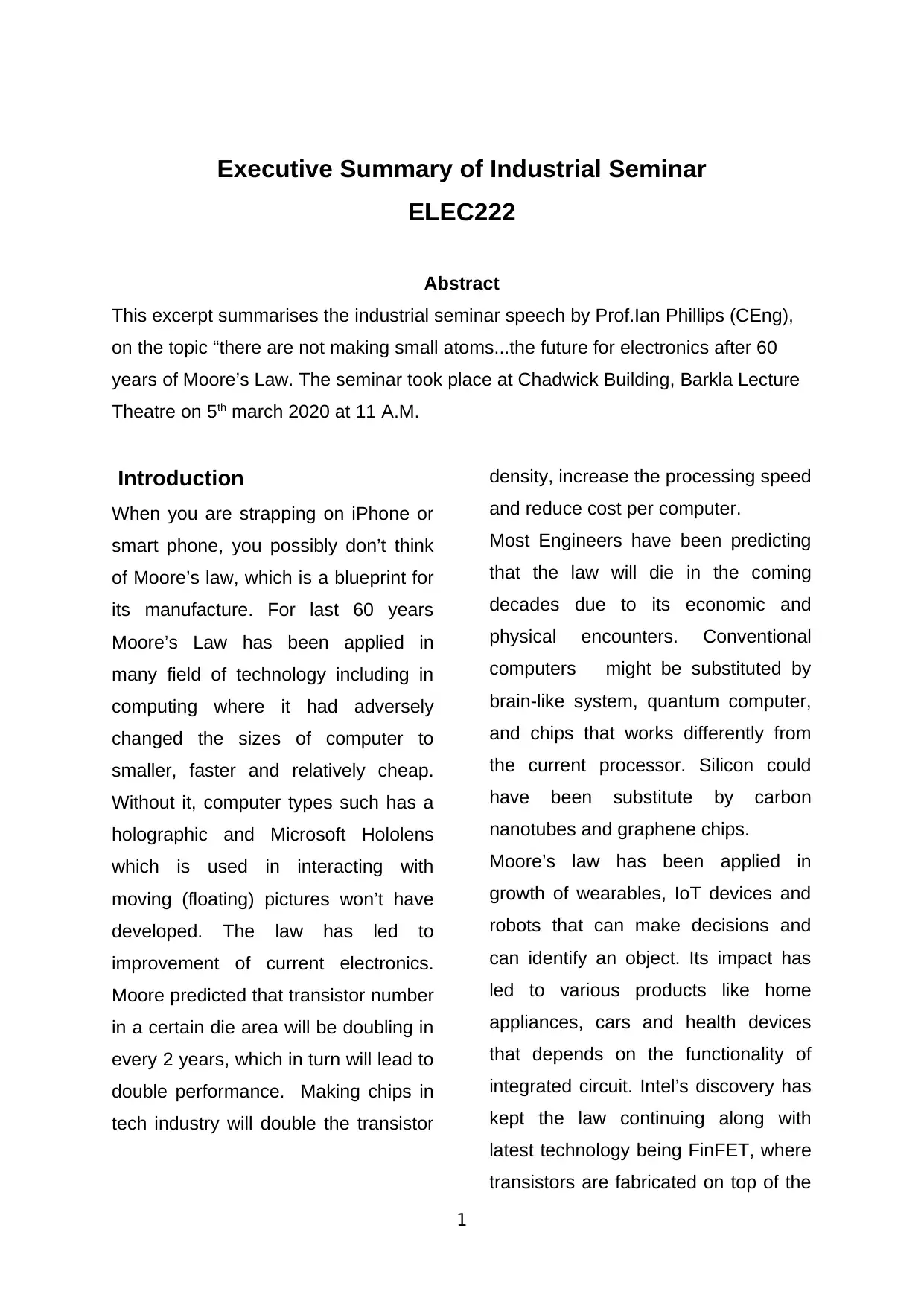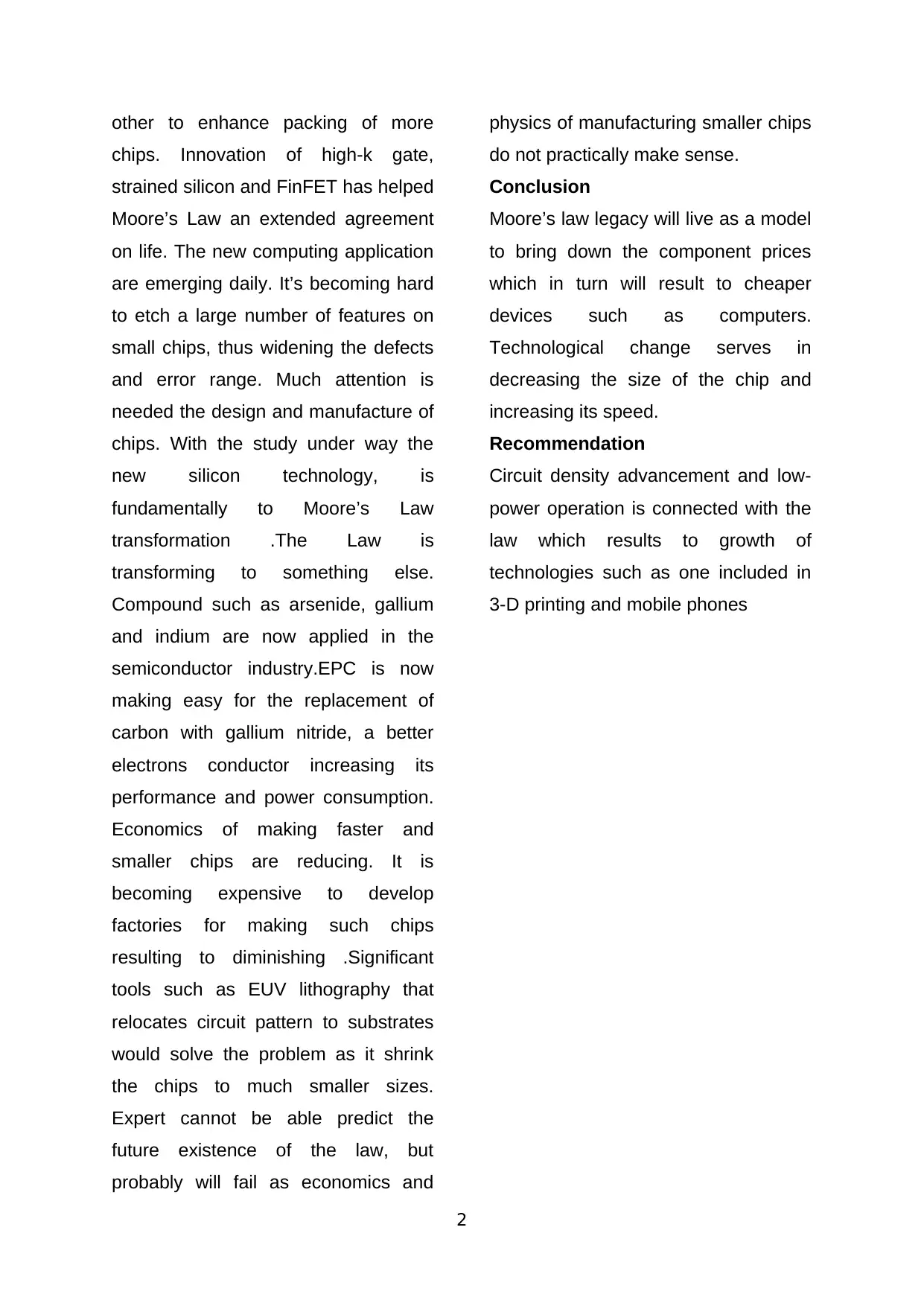University of Liverpool ELEC222 Executive Summary: Moore's Law
VerifiedAdded on 2022/08/28
|2
|638
|16
Report
AI Summary
This report provides an executive summary of an industrial seminar presented by Prof. Ian Phillips at the University of Liverpool, discussing the future of electronics in the context of Moore's Law. The seminar, held on March 5th, 2020, explored the evolution of electronics, from early technologies li...

Executive Summary of Industrial Seminar
ELEC222
Abstract
This excerpt summarises the industrial seminar speech by Prof.Ian Phillips (CEng),
on the topic “there are not making small atoms...the future for electronics after 60
years of Moore’s Law. The seminar took place at Chadwick Building, Barkla Lecture
Theatre on 5th march 2020 at 11 A.M.
Introduction
When you are strapping on iPhone or
smart phone, you possibly don’t think
of Moore’s law, which is a blueprint for
its manufacture. For last 60 years
Moore’s Law has been applied in
many field of technology including in
computing where it had adversely
changed the sizes of computer to
smaller, faster and relatively cheap.
Without it, computer types such has a
holographic and Microsoft Hololens
which is used in interacting with
moving (floating) pictures won’t have
developed. The law has led to
improvement of current electronics.
Moore predicted that transistor number
in a certain die area will be doubling in
every 2 years, which in turn will lead to
double performance. Making chips in
tech industry will double the transistor
density, increase the processing speed
and reduce cost per computer.
Most Engineers have been predicting
that the law will die in the coming
decades due to its economic and
physical encounters. Conventional
computers might be substituted by
brain-like system, quantum computer,
and chips that works differently from
the current processor. Silicon could
have been substitute by carbon
nanotubes and graphene chips.
Moore’s law has been applied in
growth of wearables, IoT devices and
robots that can make decisions and
can identify an object. Its impact has
led to various products like home
appliances, cars and health devices
that depends on the functionality of
integrated circuit. Intel’s discovery has
kept the law continuing along with
latest technology being FinFET, where
transistors are fabricated on top of the
1
ELEC222
Abstract
This excerpt summarises the industrial seminar speech by Prof.Ian Phillips (CEng),
on the topic “there are not making small atoms...the future for electronics after 60
years of Moore’s Law. The seminar took place at Chadwick Building, Barkla Lecture
Theatre on 5th march 2020 at 11 A.M.
Introduction
When you are strapping on iPhone or
smart phone, you possibly don’t think
of Moore’s law, which is a blueprint for
its manufacture. For last 60 years
Moore’s Law has been applied in
many field of technology including in
computing where it had adversely
changed the sizes of computer to
smaller, faster and relatively cheap.
Without it, computer types such has a
holographic and Microsoft Hololens
which is used in interacting with
moving (floating) pictures won’t have
developed. The law has led to
improvement of current electronics.
Moore predicted that transistor number
in a certain die area will be doubling in
every 2 years, which in turn will lead to
double performance. Making chips in
tech industry will double the transistor
density, increase the processing speed
and reduce cost per computer.
Most Engineers have been predicting
that the law will die in the coming
decades due to its economic and
physical encounters. Conventional
computers might be substituted by
brain-like system, quantum computer,
and chips that works differently from
the current processor. Silicon could
have been substitute by carbon
nanotubes and graphene chips.
Moore’s law has been applied in
growth of wearables, IoT devices and
robots that can make decisions and
can identify an object. Its impact has
led to various products like home
appliances, cars and health devices
that depends on the functionality of
integrated circuit. Intel’s discovery has
kept the law continuing along with
latest technology being FinFET, where
transistors are fabricated on top of the
1
Paraphrase This Document
Need a fresh take? Get an instant paraphrase of this document with our AI Paraphraser

other to enhance packing of more
chips. Innovation of high-k gate,
strained silicon and FinFET has helped
Moore’s Law an extended agreement
on life. The new computing application
are emerging daily. It’s becoming hard
to etch a large number of features on
small chips, thus widening the defects
and error range. Much attention is
needed the design and manufacture of
chips. With the study under way the
new silicon technology, is
fundamentally to Moore’s Law
transformation .The Law is
transforming to something else.
Compound such as arsenide, gallium
and indium are now applied in the
semiconductor industry.EPC is now
making easy for the replacement of
carbon with gallium nitride, a better
electrons conductor increasing its
performance and power consumption.
Economics of making faster and
smaller chips are reducing. It is
becoming expensive to develop
factories for making such chips
resulting to diminishing .Significant
tools such as EUV lithography that
relocates circuit pattern to substrates
would solve the problem as it shrink
the chips to much smaller sizes.
Expert cannot be able predict the
future existence of the law, but
probably will fail as economics and
physics of manufacturing smaller chips
do not practically make sense.
Conclusion
Moore’s law legacy will live as a model
to bring down the component prices
which in turn will result to cheaper
devices such as computers.
Technological change serves in
decreasing the size of the chip and
increasing its speed.
Recommendation
Circuit density advancement and low-
power operation is connected with the
law which results to growth of
technologies such as one included in
3-D printing and mobile phones
2
chips. Innovation of high-k gate,
strained silicon and FinFET has helped
Moore’s Law an extended agreement
on life. The new computing application
are emerging daily. It’s becoming hard
to etch a large number of features on
small chips, thus widening the defects
and error range. Much attention is
needed the design and manufacture of
chips. With the study under way the
new silicon technology, is
fundamentally to Moore’s Law
transformation .The Law is
transforming to something else.
Compound such as arsenide, gallium
and indium are now applied in the
semiconductor industry.EPC is now
making easy for the replacement of
carbon with gallium nitride, a better
electrons conductor increasing its
performance and power consumption.
Economics of making faster and
smaller chips are reducing. It is
becoming expensive to develop
factories for making such chips
resulting to diminishing .Significant
tools such as EUV lithography that
relocates circuit pattern to substrates
would solve the problem as it shrink
the chips to much smaller sizes.
Expert cannot be able predict the
future existence of the law, but
probably will fail as economics and
physics of manufacturing smaller chips
do not practically make sense.
Conclusion
Moore’s law legacy will live as a model
to bring down the component prices
which in turn will result to cheaper
devices such as computers.
Technological change serves in
decreasing the size of the chip and
increasing its speed.
Recommendation
Circuit density advancement and low-
power operation is connected with the
law which results to growth of
technologies such as one included in
3-D printing and mobile phones
2
1 out of 2
Your All-in-One AI-Powered Toolkit for Academic Success.
+13062052269
info@desklib.com
Available 24*7 on WhatsApp / Email
![[object Object]](/_next/static/media/star-bottom.7253800d.svg)
Unlock your academic potential
© 2024 | Zucol Services PVT LTD | All rights reserved.

